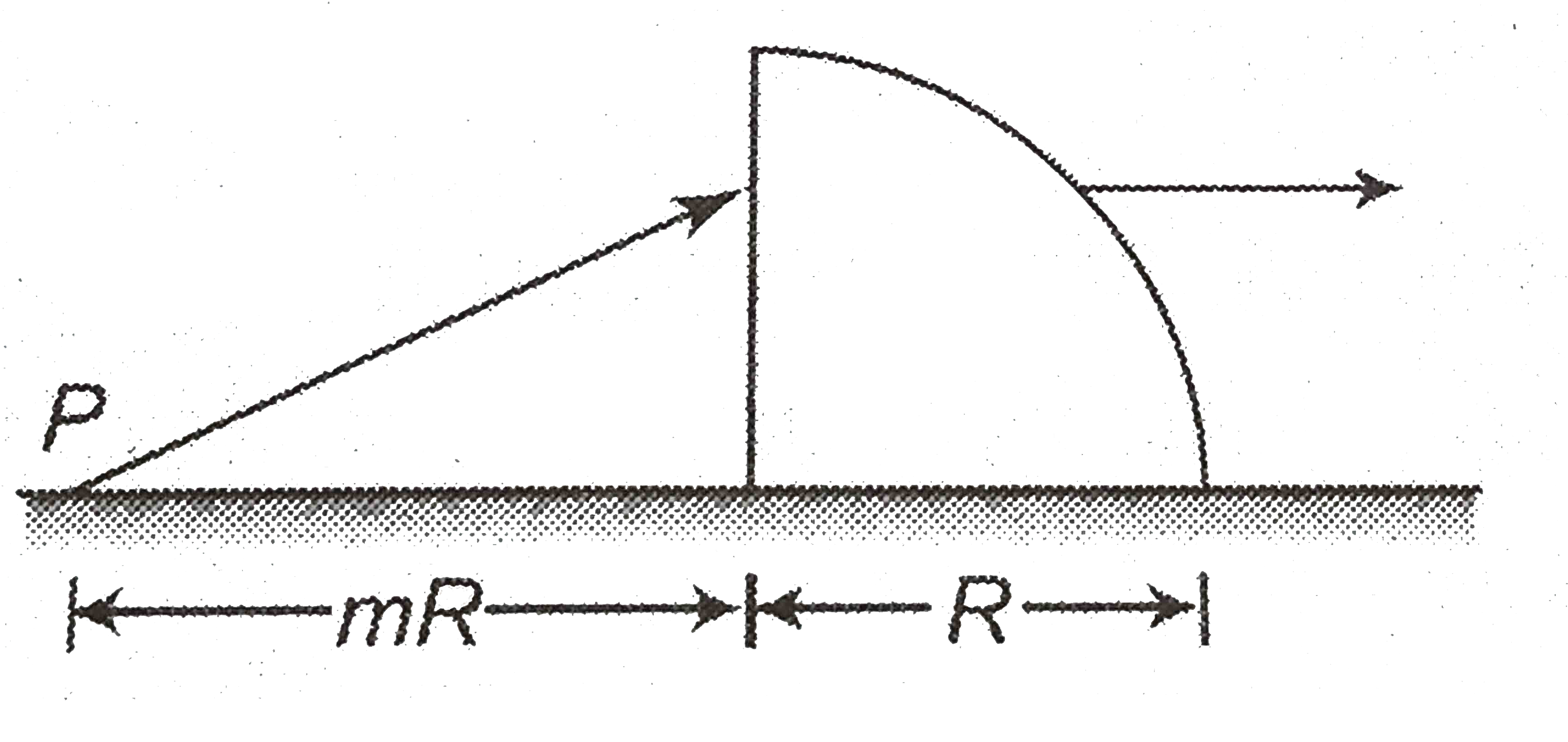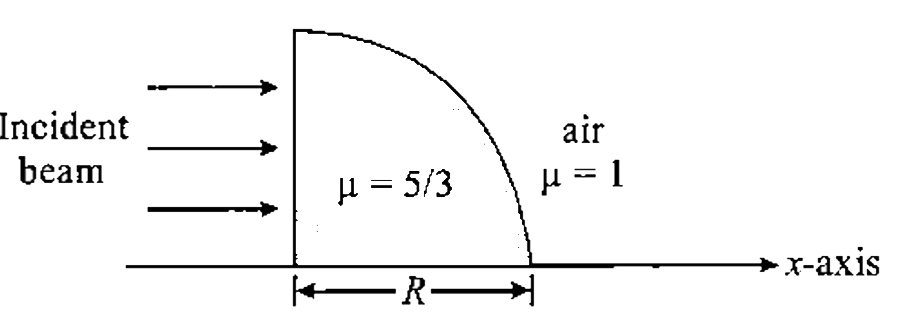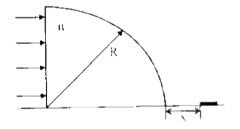A uniform,horizontal beam of light is incident upon a quarter cylinder of radiusR=5cm and has a refractive index 2/√3.A patch on the table for a distance 'x'from the cylinder is unilluminated ,find the value of 'x'?
 Solution in Gujrati
Solution in Gujrati
The correct Answer is:5 m
_E01_152_S01.png)
Sin C = 1μ = (1)/(2//sqrt(3))<br>implies C = Sin^(-1) (sqrt(3))/(2) = 60^(@)<br><imga≤ocr_imageload∈g=lazysrc=https://d10lpgp6xz60nq.cloudfront.net/physics_images/ALN_PHY_C07(II)_E01_152_S02.pngwh=80%mx-autosty≤=background:white;><br>"cos"60^(@) = (R)/(R+x) implies x = R , x = 5 cm
Topper's Solved these Questions
- GEOMETRICAL OPTICSBOOK - ALLEN CHAPTER - GEOMETRICAL OPTICSEXERCISE - EXERCISE-05 (A)
35 Videos
- GEOMETRICAL OPTICSBOOK - ALLEN CHAPTER - GEOMETRICAL OPTICSEXERCISE - EXERCISE-05 (B)
35 Videos
- GEOMETRICAL OPTICSBOOK - ALLEN CHAPTER - GEOMETRICAL OPTICSEXERCISE - EXERCISE-04[A]
23 Videos
- CURRENT ELECTRICITYBOOK - ALLEN CHAPTER - CURRENT ELECTRICITYEXERCISE - EX.II
66 Videos
- GRAVITATIONBOOK - ALLEN CHAPTER - GRAVITATIONEXERCISE - EXERCISE 4
9 Videos
Similar Questions
If two mirrors are kept at 60∘ to each other, then the number of images formed by them is ......
View SolutionA concave mirror is placed on a horizontal table, with its axis directed vertically upwards. Let O be the pole of the mirror and C its centre of curvature. A point object is placed at C. It has a real image, also located at C. If the mirror is now filled with water, the image will be.
View SolutionA plane mirror of circular shape with radius r=20cm is fixed to the ceiling .A bulb is to be placed on the axis of the mirror.A circular area of radius R=1m on the floor is to be illuminated after reflection of light from the mirror. The height of the room is 3m What is maximum distance from the center of the mirror and the bulb so that the required area is illuminated?
View SolutionIn the Bohr's model of hy drogen atom, the electron moves around the nucleus in a circular orbit of radius 5×10−11m. Its time period is 1.5×10−16s. The current associated with the electron motion is:-
View SolutionAssertion : The difference in the value of acceleration due to gravity at pole and equator is proportional to square of angular velocity of earth.
Reason : the value of acceleration due to gravity is minimum at the equator and maximum at the pole.
View SolutionA light beam of diameter sqrt(3R) is incident symmetrically on a glass hemispher of radius R and of refractive index n=sqrt(3) . Find radius of the beam at the base of hemispher.
View Solution
A quarter cylinder of radius R and refractive index 1.5 is placed on a table.A point object P is kept at a distance of mR from it. Find the value of m for whicha ray from P will emerge parallel to the table as shown in the figure.
View SolutionA vertical beam of light of cross sectional radius R2 is incident symmetrically on the curved surface of a glass hemisphere of refractive index μ=32. Radius of the hemisphere is R and its base is on a horizontal table. Find the radius of luminous spot formed on the table. sin20∘=13 and sin80∘=0.98
View SolutionA uniform, horizontal parallel beam of light is incident upon a prism as shown. The prism is in the shape of a quarter cylinder, of radius 5cm, and has refractive index 5/3. The width of the regionat which the incident rays after normal incidence on plane surface and subsequent refraction at curved surface intersect on x axis is (Neglect the ray which travels along x-axis)

View SolutionAs shown, a narrow beam of light is incident onto a semi-circular glass cylinder of radius R. Light can exit the cylinder when the beam is at the centre. When the beam is moved parallel to a maximum distance d from the central line, no light can exit the cylinder from its lower surface. Find the refractive index of the glass.

View SolutionQuarter part of a transparent cylinder ABC of radius R is kept on a horizontal floor and a horizontal beam of light falls on the cylinder in the two different arrangement of cylinder as shown in figure (a) & (b) . In arrangement (a) light converges at point D , which is at a distance 2R/m from B. And in arrangement (b) light converges at point E, which is at a distance R/(m-1) from C. Find out the refractive index of the material.
View SolutionA glass prism in the shape of a quarter cylinder lies on a horizontal table. A uniform horizontal light beam falls on its vertical plane surface as shown in the figure. If the radius of the cylinder is R = 5cm and the refractive index of the glass is n = 1.5 where on the table beyond the cylinder will a path of light be found? (in cm) Light R
View Solutionअपवर्तनांक 1.5 तथा त्रिज्या R के एक सिलिंडर का चतुर्थांश मेज पर रखा गया है | इसमें mR दूरी पर एक बिंदु - वस्तु P रखी गई है | m का वह मान ज्ञात कीजिए जिसके लिए बिंदु P से चलने वाली किरण मेज के समान्तर चित्रानुसार पारगमित हो जाए |

View Solution
A parallel beam of light is incident on a glass prism in the shape of a quarter cylinder of radius R=0.5 m and refractive index n 1.5 placed on a horizontal table as shown in the figure. Beyond the cylinder a patch of light is found whose nearest distance x from the cylinder is
View SolutionUniform, horizontal beam of light R= 5 cm The radius is incident on the one-fourth cylinder and whose refractive index 2sqrt(3) is. The space on the table up to 'x' distance from the cylinder is unadapted. Find the value of 'x'?
View SolutionAn R radius and a quarter cylinder of refractive index 1.5 is placed on a table. A point object P is placed m away from it. Find the value of m for which a ray from P will be parallel to the table according to the picture.
View Solution
